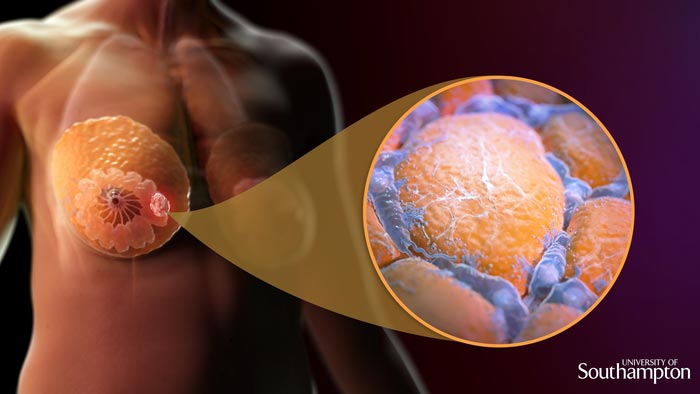New marker to personalized therapy for breast cancer

The position of the crown like structure in the human anatomy
Credit: University of Southampton
A new study from the University of Southampton has discovered that ‘crown-like structures’ surrounding breast tumours in overweight and obese patients could hinder their response to therapy.
The findings of this study could potentially be used to improve personalised treatment for patients with HER2 positive overexpressed breast cancer.
Adipose tissue, or body fat, is an important component of the healthy human breast and yet high body mass index (BMI) is associated with increased risk of developing breast cancer. Overweight patients also have worse survival rates than patients with healthy body weight.
In patients with a high BMI, increased body fat surrounding the breast can cause inflammatory immune cells, called macrophages, to gather in the breast’s fat tissue. These macrophages can then form what are called ‘crown-like structures’ by surrounding these fat cells (see picture below). This creates an inflammatory environment in the breast which can lead to the onset and growth of tumours.
How these crown-like structures go on to affect breast cancer progression and respond to therapy is largely unknown.
The research team, led by Professors Stephen Beers, Ramsey Cutress and Dr Charles Birts, assessed samples from a group of HER2+ breast cancer patients to investigate the link between high BMI and the formation of crown-like structures, and the subsequent effect of these on how patients responded to therapy with a drug called trastuzumab (Herceptin®).
The results, published in the journal Scientific Reports, showed that patients that were overweight or obese had significantly more crown-like structures in their fat tissue surrounding the tumour, and that this was associated with a faster time to metastatic disease, an indication of how well the patients have responded to therapy.
They then went on to identify a potential molecular biomarker, called CD32B, on the surface of the macrophages in these crown-like structures. When this marker was present in overweight and obese patients, their response to trastuzumab therapy was poorer.
Stephen Beers, Professor of Immunology and Immunotherapy at the University of Southampton said, “These findings will be of interest to clinicians and researchers involved in breast cancer treatment as they could potentially be used to develop personalised treatment in patients with HER2 positive overexpressed breast cancer.
“For example, doctors would know that patients with a high BMI and the marker on their crown-like structures are likely to have a poor response to trastuzumab therapy. They may therefore benefit from more intensive anti-HER2 therapy earlier in their treatment.
“On the other hand, this study highlights how effective trastuzumab treatment is in patients that do not have the marker. So these patients could benefit from a lower dose of anti-HER2 therapy which may minimise the side-effects they experience. Further studies with more patients will be needed to help confirm these initial findings.”
The research team are now looking at ways to change the behaviour of these crown-like structures to improve responses to breast cancer therapy.
This research has been published in the peer reviewed journal Scientific Reports. The research team was funded by Against Breast Cancer, Cancer Research UK, Breast Cancer Now and World Cancer Research Fund UK.
Journal: Scientific Reports
DOI: 10.1038/s41598-022-11696-6
Method of Research: Observational study
Subject of Research: Cells
Article Title: Prognostic significance of crown-like structures to trastuzumab response in patients with primary invasive HER2+ breast carcinoma
Article Publication Date: 24-May-2022
Media Contact
Stephen Bates
University of Southampton
s.d.bates@soton.ac.uk
Cell: 07342 060429
All latest news from the category: Life Sciences and Chemistry
Articles and reports from the Life Sciences and chemistry area deal with applied and basic research into modern biology, chemistry and human medicine.
Valuable information can be found on a range of life sciences fields including bacteriology, biochemistry, bionics, bioinformatics, biophysics, biotechnology, genetics, geobotany, human biology, marine biology, microbiology, molecular biology, cellular biology, zoology, bioinorganic chemistry, microchemistry and environmental chemistry.
Newest articles

Innovative 3D printed scaffolds offer new hope for bone healing
Researchers at the Institute for Bioengineering of Catalonia have developed novel 3D printed PLA-CaP scaffolds that promote blood vessel formation, ensuring better healing and regeneration of bone tissue. Bone is…

The surprising role of gut infection in Alzheimer’s disease
ASU- and Banner Alzheimer’s Institute-led study implicates link between a common virus and the disease, which travels from the gut to the brain and may be a target for antiviral…

Molecular gardening: New enzymes discovered for protein modification pruning
How deubiquitinases USP53 and USP54 cleave long polyubiquitin chains and how the former is linked to liver disease in children. Deubiquitinases (DUBs) are enzymes used by cells to trim protein…



